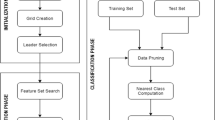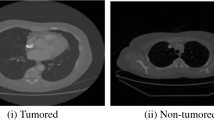Abstract
The symptoms of cancer normally appear only in the advanced stages, so it is very hard to detect resulting in a high mortality rate among the other types of cancers. Thus, there is a need for early prediction of lung cancer for the purpose of diagnosing and this can result in better chances of it being able to be treated successfully. Histopathology images of lung scan can be used for classification of lung cancer using image processing methods. The features from lung images are extracted and employed in the system for prediction. Grey level co-occurrence matrix along with the methods of Gabor filter feature extraction are employed in this investigation. Another important step in enhancing the classification is feature selection that tends to provide significant features that helps differentiating between various classes in an accurate and efficient manner. Thus, optimal feature subsets can significantly improve the performance of the classifiers. In this work, a novel algorithm of feature selection that is wrapper-based is proposed by employing the modified stochastic diffusion search (SDS) algorithm. The SDS, will benefit from the direct communication of agents in order to identify optimal feature subsets. The neural network, Naïve Bayes and the decision tree have been used for classification. The results of the experiment prove that the proposed method is capable of achieving better levels of performance compared to existing methods like minimum redundancy maximum relevance, and correlation-based feature selection.




Similar content being viewed by others
References
Zhang G, Jiang S, Yang Z, Gong L, Ma X, Zhou Z, Bao C, Liu Q (2018) Automatic nodule detection for lung cancer in CT images: a review. Comput Biol Med 103:287–300
Senthil Kumar K, Venkatalakshmi K, Karthikeyan K (2019) Lung cancer detection using image segmentation by means of various evolutionary algorithms. Comput Math Methods Med 2019:4909846. https://doi.org/10.1155/2019/4909846
Sevani A, Modi H, Patel S, Patel H (2018) Implementation of image processing techniques for identifying different stages of lung cancer. Int J Appl Eng Res 13(8):6493–6499
Thawani R, McLane M, Beig N, Ghose S, Prasanna P, Velcheti V, Madabhushi A (2018) Radiomics and radiogenomics in lung cancer: a review for the clinician. Lung Cancer 115:34–41
Kishore MR (2015) An effective and efficient feature selection method for lung cancer detection. Int J Comput Sci Inf Technol (IJCSIT) 7(4):135–141
Narayanan BN, Hardie RC, Kebede TM, Sprague MJ (2019) Optimized feature selection-based clustering approach for computer-aided detection of lung nodules in different modalities. Pattern Anal Appl 22(2):559–571
Asuntha A, Singh N, Srinivasan A (2016) PSO, genetic optimization and SVM algorithm used for lung cancer detection. J Chem Pharm Res 8(6):351–359
da Silva GL, da Silva Neto OP, Silva AC, de Paiva AC, Gattass M (2017) Lung nodules diagnosis based on evolutionary convolutional neural network. Multimed Tools Appl 76(18):19039–19055
Veeramani SK, Muthusamy E (2016) Detection of abnormalities in ultrasound lung image using multi-level RVM classification. J Matern Fetal Neonatal Med 29(11):1844–1852
da Silva GLF, Valente TLA, Silva AC, de Paiva AC, Gattass M (2018) Convolutional neural network-based PSO for lung nodule false positive reduction on CT images. Comput Methods Programs Biomed 162:109–118
D’Cruz J, Jadhav A, Dighe A, Chavan V, Chaudhari J (2016) Detection of lung cancer using backpropagation neural networks and genetic algorithm. Comput Technol Appl 6(5):823–827
Naqi SM, Sharif M, Jaffar A (2018) Lung nodule detection and classification based on geometric fit in parametric form and deep learning. Neural Comput Appl. https://doi.org/10.1007/s00521-018-3773-x
Zhang G, Jiang S, Yang Z, Gong L, Ma X, Zhou Z, Bao C, Liu Q (2018) Automatic nodule detection for lung cancer in CT images: a review. Comput Biol Med 103:287–300
Bhuvaneswari P, Therese AB (2015) Detection of cancer in lung with K-NN classification using genetic algorithm. Procedia Mater Sci 10:433–440
Kohad R, Ahire V (2015) Application of machine learning techniques for the diagnosis of lung cancer with ANT colony optimization. Int J Comput Appl 113(18):34–41
Johora FT, Jony MH, Khatun P, Rana HK (2018) Early detection of lung cancer from CT scan images using binarization technique (No. 545). EasyChair
Alhakbani H, al-Rifaie MM (2017) Feature selection using stochastic diffusion search. In: Proceedings of the genetic and evolutionary computation conference. ACM, pp 385–392
Jadhav SD, Channe HP (2016) Comparative study of K-NN, Naive Bayes and decision tree classification techniques. Int J Sci Res 5(1):1842–1845
Hosseinzadeh F, KayvanJoo AH, Ebrahimi M, Goliaei B (2013) Prediction of lung tumor types based on protein attributes by machine learning algorithms. SpringerPlus 2(1):238
Senthil S, Ayshwarya B (2018) Lung cancer prediction using feed forward back propagation neural networks with optimal features. Int J Appl Eng Res 13(1):318–325
Author information
Authors and Affiliations
Corresponding author
Additional information
Publisher's Note
Springer Nature remains neutral with regard to jurisdictional claims in published maps and institutional affiliations.
Rights and permissions
About this article
Cite this article
Shanthi, S., Rajkumar, N. Lung Cancer Prediction Using Stochastic Diffusion Search (SDS) Based Feature Selection and Machine Learning Methods. Neural Process Lett 53, 2617–2630 (2021). https://doi.org/10.1007/s11063-020-10192-0
Published:
Issue Date:
DOI: https://doi.org/10.1007/s11063-020-10192-0




